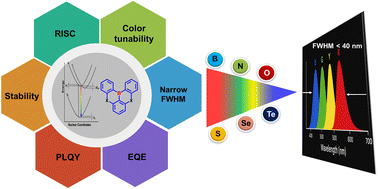Over the last decade, there has been a considerable upsurge in the development of organic emitters that produce narrowband emission and can utilize triplet excitons without relying on metal-containing components, thereby significantly advancing OLED technology. In particular, boron (B)- and heteroatom-doped polycyclic nanographenes with multi-resonance thermally activated delayed fluorescence (MR-TADF) have emerged as promising emitters. Compared with conventional donor–acceptor (D–A) TADF emitters, MR-TADF materials offer several advantages, including sharp emission spectra (a full width at half maximum of ≤40 nm), high photoluminescence efficiency, and small singlet–triplet energy gaps, making them strong contenders for next-generation OLEDs. Recently, MR-TADF emitters have demonstrated device efficiencies that surpass those of traditional TADF and phosphorescent emitters. However, several interconnected challenges persist, such as limited color tunability, sluggish exciton up-conversion rates, aggregation-induced quenching, efficiency degradation at high brightness, and limited operational lifetimes. These obstacles are often intertwined owing to fundamental “trade-offs” in material properties. Overcoming them requires precise molecular engineering and mastering material design. This review systematically examines the progress in B-based MR-TADF emitters, with a particular focus on molecular design strategies tailored to address these limitations. This study categorizes by emission color to aid the development of high-performance, full-color MR-OLEDs and concludes by outlining the current challenges and potential directions for future research on MR-TADF emitter development.
